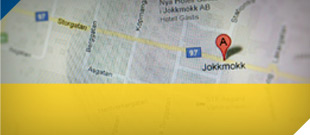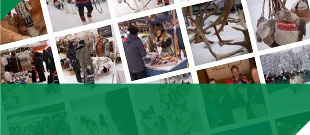The Church Town of Jokkmokk
During the archeological diggings in the 1930s prior to the construction of the town's clinic, remains of a log structure were found. The conclusion arrived at that time was that this was what was left of the first church which was completed in 1607. Remains of graves were also found. Later diggings have shown that there are other possible locations for the church. It might have been located on the ridge or beside it between what is now the Homestead Museum and Ájtte Museum. Even the market booths and a few cabins were built along the ridge. Traces of houses and Sámi hut foundations were found in the area of the Homestead Museum where the Historic Market takes place today.
From about 1690 to the end of the 18th century the vicar was placed in Hyttan or what is called Kvikkjokk today. And in Jokkmokk there was a chapel. Silver ore had been discovered in the mountains near Kvikkjokk and the crown established a smelting hut there. The silver ore was transported from where it was mined in Sarek and Bádjelandda to the smelting furnace and once processed it was transported on to the coast. The Sámi and their draft-reindeer were forced to undertake the difficult and heavy transportation of the ore. The smelting hut was manned by soldiers given the normal military pay. The operation continued for only forty years since the silver deposits did not give the earnings which they expected. But the enterprise led to some new homesteads being claimed following the shore of the Lule River from Luleå up to Kvikkjokk, homesteads which had the legal duty of housing and transporting travelers.
For a long time the village of Jokkmokk consisted only of the church, the parsonage, cabins for those attending church and market booths. In 1732 a school for Sámi children opened, and the permanent settlers increased in the person of the school master! During the 18th century there was an increase in population, both among the Sámi as well as among settlers. The oldest church was too small and a new church was inaugurated in 1753. It burned down in 1972, but a few years later a replica of the old church was rebuilt on the same place. It was built following the building plans from the 18th century. It is this church that is called the "old church".
As parish church the old church had already been replaced by the new church which was completed in 1888. The church village had continued to grow. The new church was large and stately, built to the taste of the era and fit for a town which was developing into the administrative center of the whole parish. The irregular and temporary character of buildings which had been typical for Jokkmokk up to now had by this time been replaced by a modern local development plan with square blocks and straight streets. The new church was built conforming to this grid plan. The old market booths and church cabins were torn down or moved as new construction took place.
In 1943 loans to build private homes were made available even to the reindeer-herding Sámi, despite hard opposition from the Lappish bailiffs and Norrbotten's County Administrative Board. So permanent winter housing could now be built. At the beginning of the 1950s steps were taken to provide housing for reindeer herders. Specially designed houses were constructed in "Lapp town". The area had previously been called Gielas (Sámi for pine heath). This had earlier been the location of a number of church cabins, which were now torn down.












